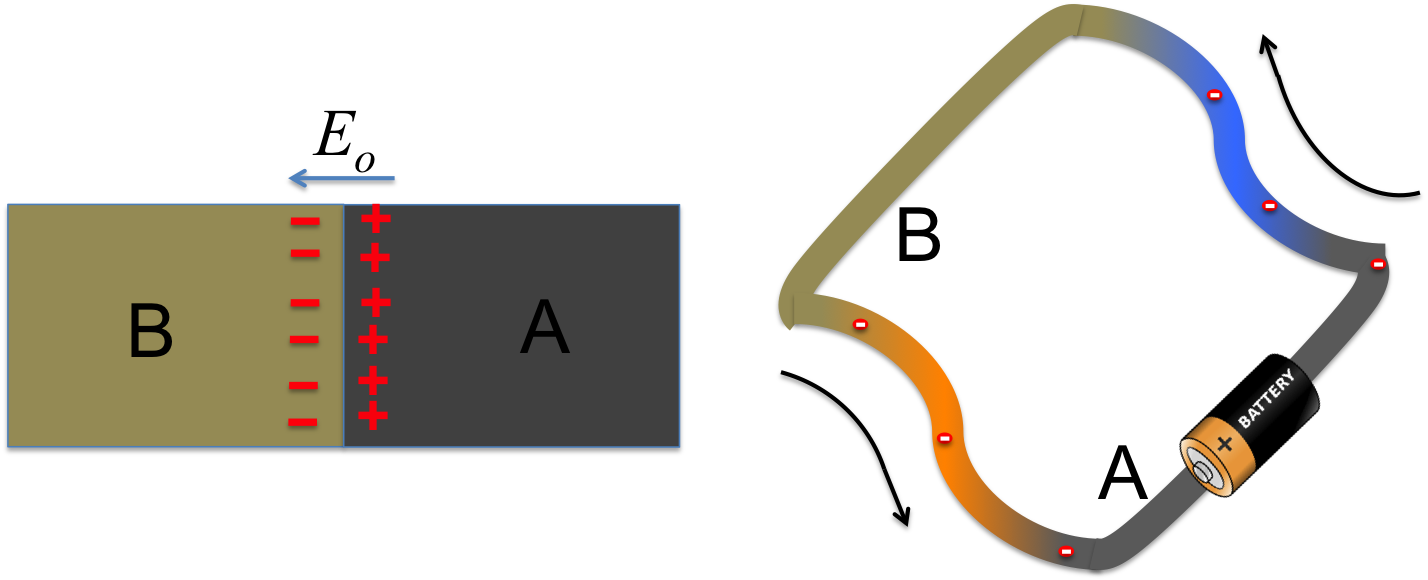The Peltier effect is the occurance of heating or cooling at a junction of two different materials when current is driven through it. It was discovered by the French physicist Jean Charles Athanase Peltier in 1834. Though it appears to be exactly the opposite of Seebeck effect, the underlying physics is somewhat different. For one, it requires junctions between two different materials to function. This is unlike the Seebeck effect, which does occur in one material and only requires a second material when one tries to measure it.
Note that Peltier effect is different from the commonly known Joule heating that occurs when current pass through a conductor. So how does Peltier effect occur?
 When two dissimilar materials are joined together, an electrostatic energy slope will form at the junction. This is simply due to the fact that different materials hold onto their electrons with different strength. Thus at the junction, one will grab some electrons from the other, creating net positive and negative charges on the two sides the interface. Note that this process doesn’t require any external driving forces, and resulting charges creates an internal electric field across the interface, thus the electrostatic energy slope. Now if we add a battery and close the loop, at one of the A/B junctions, electrons are pushed to climb up the energy hill, while at the other B/A junction, electrons move down the energy hill. Keep in mind that when electrons move in a material, they consistently collide with the ions (origin of electrical resistance) during which kinetic energy exchange will occur. When electrons move up hill, they slow
When two dissimilar materials are joined together, an electrostatic energy slope will form at the junction. This is simply due to the fact that different materials hold onto their electrons with different strength. Thus at the junction, one will grab some electrons from the other, creating net positive and negative charges on the two sides the interface. Note that this process doesn’t require any external driving forces, and resulting charges creates an internal electric field across the interface, thus the electrostatic energy slope. Now if we add a battery and close the loop, at one of the A/B junctions, electrons are pushed to climb up the energy hill, while at the other B/A junction, electrons move down the energy hill. Keep in mind that when electrons move in a material, they consistently collide with the ions (origin of electrical resistance) during which kinetic energy exchange will occur. When electrons move up hill, they slow
 down and will take energy from the ions during the collisions, thus the material at that junction cools. On the other side, electrons move down the energy hill and accelerate. During the collisions with ions, they release energy to the ions, thus the material heat up there. So basically, electrons simply carry the thermal energy (vibration of the ions) from one junction to the other. This is why that the thermoelectric cooler always need a heat sink on one side to dissipate the thermal energy, as shown in the following video. To achieve efficient cooling (Peltier effect) or power generation (Seebeck effect), p- and n-type semiconductors are usually used in actual devices, since they have Seebeck coefficients of the opposite signs that add onto each other across the loop.
down and will take energy from the ions during the collisions, thus the material at that junction cools. On the other side, electrons move down the energy hill and accelerate. During the collisions with ions, they release energy to the ions, thus the material heat up there. So basically, electrons simply carry the thermal energy (vibration of the ions) from one junction to the other. This is why that the thermoelectric cooler always need a heat sink on one side to dissipate the thermal energy, as shown in the following video. To achieve efficient cooling (Peltier effect) or power generation (Seebeck effect), p- and n-type semiconductors are usually used in actual devices, since they have Seebeck coefficients of the opposite signs that add onto each other across the loop.
As discussed previously, the Peltier effect relies on the electrostatic energy slope that build up at the interface between different materials. However, the same thing could occur within one material too, provided that the energy of electrons at different locations of that material become different due to other factors, such as different temperature (en? that sounds like Seebeck effect). Indeed, this is what Thomson effect is about. Then there is a temperature gradient in a material, an electrostatic potential slope build up. When current is driven through such a material, depending on the direction of current, it will gain or release thermal energy.
